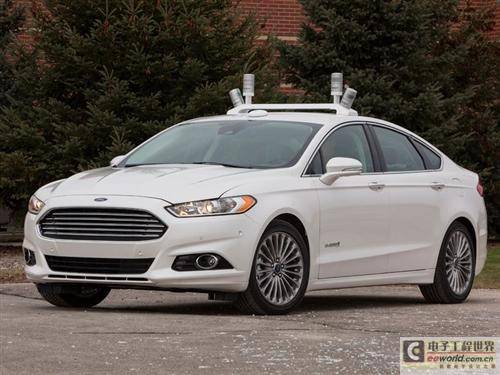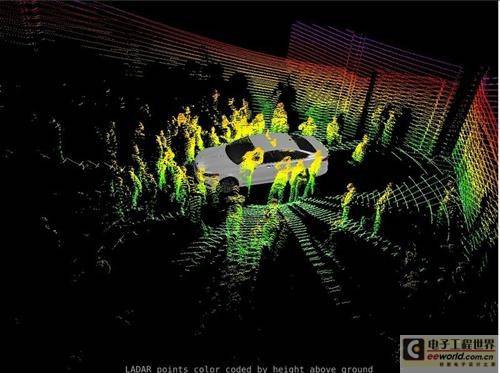
Last month, Ford showed off a Ford Fusion Hybrid self-driving test car. Currently, Ford is working with MIT and Stanford University to develop self-driving technology. MIT is mainly responsible for the traffic conditions around the car, while Stanford University is responsible for studying how to maximize the performance of the on-board sensors when there are obstacles around.
In other words, the research purpose of the former is to use vehicle-mounted cameras to collect directly visible (line-of-sight) traffic data, and use this to understand and predict road conditions; the latter is dedicated to collecting road condition information in situations where the field of vision is blocked (non-line-of-sight), such as using V2X technology.
The Ford Fusion test car includes safety technologies currently available on Ford production vehicles, plus four radar sensors and real-time 3D maps.
Ford and MIT collaborate to collect direct and visible road data
Although the radar sensor itself can detect the road conditions around the car, Ford has also developed an advanced algorithm in a collaborative project with MIT to help the vehicle system predict the future movement of other vehicles and pedestrians after collecting the current road conditions. Ford calls it "scenario planning." Through this predictive planning solution, the car can better evaluate and predict potential risks in the surrounding road conditions, so as to avoid pedestrians, vehicles and other moving objects in a timely and effective manner.
Greg Stevens, Ford's global manager of driver assistance and active safety, said that in this collaborative project, the evaluation and prediction of vehicle movement patterns have achieved significant results, and the next step of the project is to strengthen the prediction of pedestrian movement patterns. The system has the ability to predict mainly by analyzing the target object from three aspects.
Predict vehicle movement patterns
The first is the physical properties of the vehicle, such as its acceleration, braking, lane changes, etc. Based on these properties, the movable range of the vehicle in front is limited to a small space, which improves the accuracy of the prediction. The second is to analyze the relationship between other vehicles and the vehicle, such as a car moving from another lane to the lane where the vehicle is located. Finally, the system will combine the second point with the comprehensive road conditions for further analysis. For example, when the navigation system or camera finds that there is a ramp exit ahead and another car is changing lanes to the lane at the exit, the system will think that the car is preparing to enter the ramp.
Predicting pedestrian movement patterns
Greg Stevens said that predicting pedestrians' movement is more challenging. Although they move slower than cars, they move more suddenly and irregularly. For example, a pedestrian who was originally walking straight ahead may suddenly cross the road.
However, the researchers still proposed two possible scenarios that can predict pedestrian behavior. The first one is that when a pedestrian suddenly looks back while walking, it is very likely that he is about to cross the road. The other one is that when a pedestrian walks towards the direction of the crosswalk, it can also be considered that he is about to cross the road.
At the 2014 North American International Auto Show, Ford displayed a test vehicle and used a sensor system to demonstrate a 3D view of traffic data obtained by the vehicle's in-vehicle safety system.
Ford and Stanford University collaborate to collect data on road conditions blocked by obstacles
Ford and Stanford University's research project focuses on how to detect traffic conditions blocked by obstacles. When a driver's view is blocked by a large truck in front of them, they will subconsciously look out. The sensors in the system developed by the project can detect the emergency braking of the vehicle in front and make evasive actions. Before that, the system will first analyze whether there is enough space in the adjacent lane for the vehicle to change lanes. The project is still in its early stages.
Autonomous driving is the main subject of Ford's Blueprint for Mobility, which describes the concept of transportation in 2025. After Ford launched its autonomous driving test car, it will continue to explore the social, legislative and technical options suitable for fully autonomous driving.
It is generally believed that V2V is a multi-object interactive technology, which still faces many technical challenges. For example, drivers in a certain area need to communicate in the same language, and a unified congestion management strategy needs to be formulated in each V2V channel.
Greg Stevens said that our goal is to enable drivers to easily use relevant technology to predict upcoming traffic conditions, make the relevant knowledge of autonomous driving become people's "common sense", and let people know that whether it is visible road conditions or road conditions blocked by obstacles, fully mastering them is very important for driving safety.
Previous article:Research and analysis on the technical application of hybrid electric vehicles
Next article:These car technologies could slash your car commute time
- Popular Resources
- Popular amplifiers
- Car key in the left hand, liveness detection radar in the right hand, UWB is imperative for cars!
- After a decade of rapid development, domestic CIS has entered the market
- Aegis Dagger Battery + Thor EM-i Super Hybrid, Geely New Energy has thrown out two "king bombs"
- A brief discussion on functional safety - fault, error, and failure
- In the smart car 2.0 cycle, these core industry chains are facing major opportunities!
- The United States and Japan are developing new batteries. CATL faces challenges? How should China's new energy battery industry respond?
- Murata launches high-precision 6-axis inertial sensor for automobiles
- Ford patents pre-charge alarm to help save costs and respond to emergencies
- New real-time microcontroller system from Texas Instruments enables smarter processing in automotive and industrial applications
- Innolux's intelligent steer-by-wire solution makes cars smarter and safer
- 8051 MCU - Parity Check
- How to efficiently balance the sensitivity of tactile sensing interfaces
- What should I do if the servo motor shakes? What causes the servo motor to shake quickly?
- 【Brushless Motor】Analysis of three-phase BLDC motor and sharing of two popular development boards
- Midea Industrial Technology's subsidiaries Clou Electronics and Hekang New Energy jointly appeared at the Munich Battery Energy Storage Exhibition and Solar Energy Exhibition
- Guoxin Sichen | Application of ferroelectric memory PB85RS2MC in power battery management, with a capacity of 2M
- Analysis of common faults of frequency converter
- In a head-on competition with Qualcomm, what kind of cockpit products has Intel come up with?
- Dalian Rongke's all-vanadium liquid flow battery energy storage equipment industrialization project has entered the sprint stage before production
- Allegro MicroSystems Introduces Advanced Magnetic and Inductive Position Sensing Solutions at Electronica 2024
- Car key in the left hand, liveness detection radar in the right hand, UWB is imperative for cars!
- After a decade of rapid development, domestic CIS has entered the market
- Aegis Dagger Battery + Thor EM-i Super Hybrid, Geely New Energy has thrown out two "king bombs"
- A brief discussion on functional safety - fault, error, and failure
- In the smart car 2.0 cycle, these core industry chains are facing major opportunities!
- The United States and Japan are developing new batteries. CATL faces challenges? How should China's new energy battery industry respond?
- Murata launches high-precision 6-axis inertial sensor for automobiles
- Ford patents pre-charge alarm to help save costs and respond to emergencies
- New real-time microcontroller system from Texas Instruments enables smarter processing in automotive and industrial applications
- There is a program with a total of 10 feeders
- Funny point, STM32 settings
- Why can't DSP connect? TMS320C6416T+seed-XDS510 PLUS
- Application of TI's high-performance charging and discharging solution in battery test equipment (Battery Test System)
- About the multi-channel link problem of sim7600ce
- Smart network desk lamp, project submission
- We are looking for positions such as speaker R&D and manufacturing engineers.
- Serial communication-What is the reason for the decrease of impedance to ground?
- [Evaluation of SGP40] + STM32CUBE + STM32G4 + UART communication test sensor
- Electric Blanket Thermostat


 ICL7612ACTV+
ICL7612ACTV+











 京公网安备 11010802033920号
京公网安备 11010802033920号